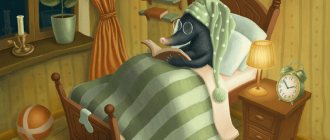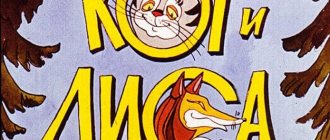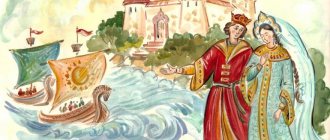What bedtime stories should you read to your child?
When choosing books to read to children at night, pay attention to the following points:
- There is no one universal “to read” list for children of a certain age. The interests of each child are individual and may differ from generally accepted canons. Therefore, do not insist on reading all recommended books, choose what your child likes
- Do not rush to purchase books according to the recommendations of authoritative sources. Take collections of works for preschoolers from the library or from friends, try reading fairy tales, stories and poems by different authors and on different topics. This way you can easily determine which works your child liked, and in what direction you should select literature in the future.
- There is no strict division of works by age. Older children can enjoy listening to fairy tales for younger ones, actively participate in their discussion, and share their own thoughts or impressions on the topic.
- The duration of reading is determined by the child’s attention. As soon as the child begins to get distracted or bored, you should stop reading. It’s better to read less – 5-10 minutes, but every day
- Children find it very interesting to listen to fairy tales about similar characters. Therefore, when choosing a work, pay special attention to fairy tales where the main characters are children.
- A good children's book is not only an interesting literary text, but also the creativity of the illustrators. Take breaks while reading, show your child illustrations, describe and discuss them. If possible, compare illustrations drawn by different artists for the same fairy tale.
- Reading at night will only be beneficial if it is enjoyable for both the adult and the child. If a book is not to the liking of one of the participants, it needs to be “put aside”
Does your child often demand to reread their favorite fairy tale over and over again? Do not refuse him this, even if you have to do it for the 10th time. When rereading a familiar fairy tale, the child feels comfortable, since he already knows what will happen to the main character and how the story will end.
At the same time, his attention is focused on previously unnoticed details, semantic nuances, individual words or sentences. A favorite childhood book can be remembered for a lifetime.
The tale of how Fedya saved the forest from an evil sorcerer
In the summer, the boy Fedya Egorov came to rest in the village with his grandparents. This village stood right next to the forest. Fedya decided to go into the forest to pick berries and mushrooms, but his grandparents did not let him in. They said that the real Baba Yaga lives in their forest, and for more than two hundred years no one has gone to this forest.
Fedya did not believe that Baba Yaga lived in the forest, but he obeyed his grandparents and did not go into the forest, but went to the river to fish. The cat Vaska followed Fedya. The fish were biting well. There were already three ruffs floating in Fedya’s jar when the cat knocked it over and ate the fish. Fedya saw this, got upset and decided to postpone fishing until tomorrow. Fedya returned home. Grandparents were not at home. Fedya put away the fishing rod, put on a long-sleeved shirt and, taking a basket, went to the neighbor’s children to invite them into the forest.
Fedya believed that his grandparents had written about Baba Yaga, that they simply did not want him to go into the forest, because it is always very easy to get lost in the forest. But Fedya was not afraid of getting lost in the forest, since he wanted to go into the forest with friends who had lived here for a long time, and therefore knew the forest well.
Much to Fedya’s surprise, all the guys refused to go with him and they began to dissuade him. Read the story to the end...
Educational bedtime stories for children
Cautionary tales
Preschool children love to talk about moral standards of behavior, about what is good and what is bad. Therefore, educational fairy tales always arouse great interest and emotional response among children.
Such fairy tales help to cultivate positive qualities in a child: kindness, responsiveness, responsibility. Parents can remember or quote fragments of educational tales when similar situations arise in the lives of their children. Instructive and educational works for children: 1. For the little ones – collections of folk tales of an instructive nature, Tamil Ivanchenko “Little instructive tales for Manyun”, collections of therapeutic tales “Tales from Tears”, “Tales from Whims”, “Sleepy Tales”, Lilia Nosova “Mother’s Tales” 2. For older children you can offer works: V.A. Oseeva “Who is the stupidest of all”, “Bad”, “The Magic Word” and other stories and fairy tales, S.A. Baruzdin “Tales of the Tram”, “ Brave Piglet”, “Cunning Handsome”, L. Panteleev “Fenka”, “Two Frogs”, E. Uspensky “Instructive Stories about the Boy Yasha”
Alphabet of your body
R - arm - a paired upper limb of a person, consisting of several sections: hand, wrist, forearm, elbow, shoulder. What is it for?
| What do you need your hand for? Think about it a little. You use your hand to put on your boots. And she will help you eat the porridge and drink the juice. Can you help Granny Threads wind everything into a ball? And pull the boy by the nose, and the girl by the braid. And without fingers you won't be able to pick your nose. In general, take care of your hands! Try not to break them! After all, it’s really hard to play with a broken arm. And be careful with fire! And with hot water! Well, take sharp objects out of sight! And the hands will say thank you. They will help you. You can do everything in the world that you can dream of. |
N - Leg - a paired lower limb of a person, consisting of several sections: foot, ankle, lower leg, knee, thigh. What do you need it for?
| Jump, run and gallop, or just kick the ball. Legs are very important. Everyone needs legs. You can measure puddles with them, Or run into the distance from the cold. Jump over a rolling pin, or bounce them in a dance. You need to take care of your feet. Protect them from diseases. Do not freeze them in winter, douse them with water in summer. |
C - The heart is the main organ of the circulatory system, located in the chest on the left, divided into two halves. It is a muscular organ that pumps blood throughout your body. What do you need it for?
| We have a heart in our chest. This organ is top class! It drives our blood, It gives us love. Like a car without an engine, it won't go anywhere. So you and I are without a heart, neither here nor there. |
G - The stomach is a hollow muscular organ. Responsible for food processing. What do you need it for?
| After chewing a piece of bun, you swallow it yourself. It gets into the stomach to swim there in the juice. This juice is not at all simple, you can’t wash it down with water. There are a lot of enzymes there, all the food goes there. Love your stomach, feed it well. Don’t chew any nasty stuff, don’t swallow it, just spit it right away. |
Since my daughter liked her mother’s creativity so much, I decided to come up with instructive stories on various topics in advance. They are not finished yet, I am constantly adding something new, or removing some phrases. Perhaps, when the time comes to read them to my daughter, there will be nothing left of the original version... I really hope that when the time comes, such stories will help both her and me in communicating with each other, and we will overcome the difficult transitional age with ease.
Funny fairy tales for children
The instructive nature of a fairy tale often manifests itself in a humorous situation. Funny stories in no way weaken the educational impact on the child, but on the contrary, strengthen it.
Children really like such works, they lift their spirits, put them in a positive mood, and develop a sense of humor. They say that a sense of humor in children is a sign of intelligence. Here you can recall many wonderful children's authors; read to your preschooler the fairy tales of G. Oster, B. Zakhoder, V. Suteev, E. Uspensky, D. Kharms, stories by N. Nosov, V. Dragunsky, V. Golyavkin.
Funny tales
Interesting bedtime stories for children, educational tales
Children of preschool age are curious and inquisitive, they are interested in literally everything, because it is in preschool age that the child accumulates knowledge and personal experience, which become the basis for further school education.
- A fairy tale is an indispensable tool that allows you to tell your child about complex things in simple, accessible language. For example, a funny story about a droplet’s journey describes the water cycle in nature and answers many children’s “whys.” The works of L. Tarasenko from the series “Educational Fairy Tales” will help children learn a lot of interesting things about the world around them.
- Natural history tales and stories occupy a special place among educational works. The works of V. Bianki, N. Sladkov, E. Shima, N. Pavlov, E. Permyak immerse you in the world of nature, reveal secrets about the life of birds and animals invisible to the human eye, teach kindness and humanity
Bianchi and others Native nature
Mouse Peak
In a small hole, in the corner of the largest room in the village house, lived the mouse Peak. He moved there only recently, so he hasn't made any friends yet. He was bored, and Pieck decided to take a walk around the yard. Hesitantly crossing the threshold, he stopped. Still a little scary. To give himself confidence, he sang: “One step, two steps.”
So I went out for a walk. One step, two steps. I will sing songs!
As always, the song helped him.
- Hello Sunshine! - he shouted.
It turned in his direction, smiled and affectionately stroked his small gray ears with its ray.
- Hello, weed!
And the blades of grass lightly tickled Peak’s bare paws, showering them with drops of dew. This made the mouse’s mood even better, and he laughed loudly.
-Who's laughing here? - a thin voice was heard. - It’s me, the mouse Peak. And who are you? - I am Fai's snail.
Peak turned around and saw a cute little snail on a leaf of a large burdock tree. Her house was a soft pink color, and droplets of dew glistened on it. Above the blue eyes, which looked with curiosity and wariness, rose cute horns.
“Don’t be afraid of me,” said the mouse. — I recently settled here, and I have no friends or acquaintances. — There’s no one at all? - asked Faya. “Absolutely, completely,” Pieck sighed sadly. -Will you be friends with me? - Will. I love it when there are a lot of friends. It's more fun this way. - Hooray! - the mouse even screamed with joy. “Come on, I’ll introduce you to the others.”
Pieck put the little snail on his shoulder, and the two of them went for a walk. This is how the mouse began his acquaintance with the inhabitants of the yard where he was to live.
They went through the gate and heard loud cackling. A large motley hen, flapping its wings, rushed around the yard, trying to gather its little yellow-throated babies under its wing. - Where, where, where, where! Come on home! To me! Here! - she shouted, running after the chickens.
And the yellow lumps, frolicking and laughing, ran away from her in different directions.
“This is Klusha’s mother,” Faya introduced the chicken. — She always runs after her chickens and screams loudly. Get used to it.
The kids were very curious, and as soon as they noticed Peak, they rushed to him. Mom Klush, seeing the stranger who was surrounded by her beloved children, almost fainted.
- Where, where! Where-where! - she screamed even louder and rushed at the uninvited guest, sweeping away everything in her path.
Little Faya could barely shout over the chicken: “Don’t be afraid, Mama Klusha!” This is Peak! He is my friend!
The chicken stopped and looked at the mouse. -You won't hurt my kids? - she asked sternly. - Of course not! I want to be friends with you! - Pieck answered, and his thin tail curled into a ring.
Attracted by the noise, a kitten came running. It was fiery red in color and resembled a small fluffy sun. - Meow! Hello. “I am Syoma,” he said. -Will you be friends with me? - Certainly. I'll be very happy! - And with me? Quack quack! - the duckling Tyapa has already approached.
He always walked with a waddle, leisurely, but he swam very quickly and was proud of the fact that he could dive. He always took care of his snow-white feathers and bright red beak.
- Certainly! - Pieck shouted.
He was very happy that he had so many friends. Everyone began to ask him where he came from, where and how he had lived before. The chickens screamed the loudest. - Where are you from? - shouts Tsyp. - What did you eat there? - Tsap squeaks. - Why is your fur coat gray? - Tsup asks with a smart look. -Are you staying with us for a long time? - this is already Tsop. -Will you play with us? — the smallest of the brothers, Tsep, timidly asked.
Pieck did not have time to answer questions. But then the hostess came out and called everyone to breakfast. The yard was instantly empty. And the mouse and the snail went on for a walk, they had already eaten. Friends walked and rejoiced that today was such a wonderful day. The grass is green, the sun is bright, there is a warm breeze, birds are flying around. Piku wanted to sing again, only not for courage, but out of happiness. - Faya, do you like to sing? - he asked. “Yes, but I don’t know many songs,” the snail sighed sadly. — I just composed a song. Do you want me to sing? “Go ahead,” she replied. - And I will sing along! And they sang:
| - Oh, what a good day! You sit down on a stump with me, we’ll sing a song together, and then we’ll go for a walk! If something happens suddenly, I have a best friend. Me and you, you and me - Best friends together! It's good with you two! You sit on my shoulder. Let's have fun playing! Let's sing songs! |
So they walked around the yard, singing a song, happy because today was just a good day, the sun was shining, and there were so many friends nearby!
My daughter and I started studying parts of the human body last year. And to make it easier for her to remember everything, I began to put the explanations into poetry. She liked it - and now we are looking for rhymes together to compose another poem.
Bedtime stories for children about cars and animals
Many children, and especially boys, are fascinated by various technical things - they like to watch cars and admire their speed and power, they enjoy playing with toy cars, organizing races or setting up a construction site in the middle of the children's room. A fairy tale in which cars are the heroes will be of great interest to such kids.
- For the little ones, toy books designed in the shape of cars, with simple text and bright drawings are suitable.
- For older children, choose fairy tales with a more complex plot, where the main characters are cars. With these books, the child will learn what kinds of cars there are and how they work, how cars help build houses and roads, harvest crops, and put out fires.
Fairy tales about cars
Children 2-5 years old often ask to read fairy tales about the same fairy-tale animal, for example, a kitten, a bunny or a mouse. This happens because the child associates himself with his favorite hero, and sometimes even asks to put him in a situation that he himself lived. Such fairy tales are a great way to instill moral values and show a child how to act in a given situation.
- Little fairy tales and stories about the lives of not fairy-tale, but real animals and birds will broaden their horizons and introduce the child to amazing facts from the life of our little brothers
Obeshchaikin
Once upon a time there was a boy Fedya Egorov. Fedya did not always keep his promises. Sometimes, having promised his parents to clean up his toys, he got carried away, forgot and left them scattered.
One day Fedya’s parents left him alone at home and asked him not to lean out of the window. Fedya promised them that he would not lean out of the window, but would draw. He took out everything he needed for drawing, sat down in a large room at the table and began to draw.
But as soon as mom and dad left the house, Fedya was immediately drawn to the window. Fedya thought: “So what, I promised not to peek, I’ll quickly peek out and see what the guys are doing in the yard, and mom and dad won’t even know that I was peeking.”
Fedya placed a chair near the window, climbed onto the window sill, lowered the handle on the frame, and before he even had time to pull the window sash, it swung open. By some miracle, just like in a fairy tale, a flying carpet appeared in front of the window, and on it sat a grandfather unfamiliar to Fedya. Grandfather smiled and said:
- Hello, Fedya! Do you want me to give you a ride on my carpet? Read the whole story...
Bedtime stories for children under one year old
Children under one year old can be shown colorful small cardboard books and read short nursery rhymes, rhymes and songs.
- Books for little ones should have thick cardboard pages; one-year-old babies like to leaf through books, sometimes without even looking at the illustrations - they are fascinated by the very process of turning the pages
- Closer to the year, when the child has the opportunity to actively move and explore the world around him, interest in books fades away. Do not insist on reading; show your child books from time to time; if the child does not show interest, put the books aside for a while
Bedtime stories for children 2-3 years old
What to read to children 2-3 years old
- At this age, you can begin to consider reading as part of your bedtime ritual.
- Choose books with dense pages, bright illustrations, and a simple plot.
- Children 2-3 years old look at the illustrations with interest. Offer your child so-called books to look at - without text
Books to look at
From the age of three, you can read longer works at night, dividing the fairy tale into two or three evenings. The child will already be able to remember where you stopped last evening. As you continue reading the story, remember together the main points from what you read. Continued reading develops memory and the ability to briefly retell content.
At this age, you can read short educational fairy tales that introduce the child to letters, numbers, colors, and some information about the world around him, for example, about the water cycle in nature.
Larisa Tarasenko Educational tales Travel of a droplet
Bedtime stories for children 4, 5 years old
In 4-5 year old children, attention becomes more stable; children can listen and follow the plot of a work for 20-25 minutes.
- After reading a fairy tale, it is advisable to analyze the plot with your child and discuss the essence of the work.
- At the same time, do not forget that the perception and imagination of a child is very different from the understanding of an adult. Let the child imagine the fairy tale himself and explain its meaning, do not insist on your own, “adult” version
- Continue the practice of analyzing text and illustrations
The best books for children 4-5 years old
What bedtime stories should I read to 6- and 7-year-old children?
The range of reading for children aged 6-7 years is expanding significantly and is being replenished with works of various subjects.
- At this age, the child is formed as a future independent reader; he can independently choose a book from among those offered
- If your child is already reading on his own, don’t stop reading to him at night. Traditional bedtime reading brings children and parents closer together and helps to cultivate a reading interest in children.
- Start keeping a reading diary with your child. Enter information about the books you have read: author, title, main characters, your own reviews, favorite quotes.
- Invite your child to draw the main character or a picture for an episode they like. Keeping such a diary contributes to a better understanding of what you read and develops the ability to express your thoughts clearly and clearly.
What to read to children 6-7 years old
“How the dog Barbos suddenly meowed”
Everyone knows that dogs bark and cats meow.
And you, (name), of course, know this. But I will tell you an extraordinary story.
Once upon a time there was a dog Barbos. He was big, big. He guarded his master's house. If someone stranger approached the fence, he began to bark loudly: “WOOF! WOOF! WOOO! And therefore his owner was calm - no stranger would get into his house.
In general, the dog Barbos was a kind dog. He ran across the lawn in front of the house and caught butterflies and all kinds of midges. True, if a neighbor's cat ran into his territory, he would bark again and drive it away. After all, everyone knows that dogs don’t like cats.
But one day the incredible happened. A scary, hunchbacked old woman walked past the fence. Barbos began to bark, as usual, “WOOP! WOOO!” But the old woman, not paying attention to him, opened the gate and entered the yard. Barbos became very angry and bit the old woman on the leg so that she would not walk around other people's yards. The old woman turned to the dog, looked at it with evil eyes and said: “Because you bit me, I will punish you. I am an evil witch. And now you will no longer bark, but will meow like a cat!” The old woman said this and disappeared, as if she had evaporated into thin air.
Barbos wanted to bark, but instead of “WOOF!”, he said: “MEOW!” He coughed, clearing his throat, and wanted to bark again. But he meowed again.
Barbos was so scared that he couldn’t find a place for himself, he ran around the yard and meowed helplessly: “MEOW! MEOW!"
The neighbors' cats heard that someone was meowing in the neighboring yard and thought that a stray cat had come there. They ran into the yard, looked around - there was no one except Barbos. And Barbos rushed after them to drive them out of his yard, but again he could not bark, but only said: “MEOW!” The cats even stopped in surprise and sat down on the ground. Where have you seen dogs meow?
“Barbos, what happened to you,” they asked the dog.
And Barbos told them about the evil witch in real cat language.
- Wow! - the cats were surprised. - What to do now? How to restore your ability to bark? After all, the owner can kick you out of the house - why does he need a meowing dog?
And Barbos grabbed his head with his paws and just whined pitifully.
The cats called all their friends from neighboring yards and began to confer. They thought about how to help Barbos.
“Barbos,” they asked the dog, “if we help you, will you no longer chase us and scare us?”
- MEOW! - Barbos said plaintively, which meant: “Never.”
And then one white cat remembered that a good witch lived in the neighboring village.
“We need to go get her, maybe she will help Barbos.”
All the cats agreed with her. Two cats stayed with Barbos to calm him down, and the rest ran to the neighboring village.
Two hours later they returned with the good witch. She was young and beautiful, and she had a magic wand in her hand. She looked at Barbos, who was meowing pitifully, then she waved her magic wand and, lo and behold, Barbos said: “WOOF!”
He did not immediately believe his luck and continued to bark and bark.
The good sorceress patted Barbos on the back and left.
And from then on, the cats were no longer afraid of Barbos, because he kept his promise: he never chased them and did not scare them with his barking.
Since then, the cats and Barbos have become friends. After all, only true friends help a friend in trouble.











